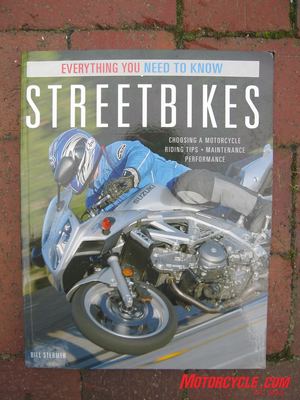"Everything You Need To Know About Streetbikes" Book Review
“Your problem is with the primary drive, not the transmission,” my neighbor said as he hovered over my shoulder. He is an engineer, so I usually just suffer through his exactitudes. This time, though, his tone got to me.
“Oh, right. The primary. Sue me,” I responded. I have an ego.
“There is a difference,” he noted. He began to look concerned that I wouldn’t get it. I was concerned my torque wrench would end up covered in blood and housed in a plastic bag festooned with a tag that read: Prosecution Exhibit A.
I didn’t respond. Perhaps I was distracted by the acrid stench of my smoldering ego assaulting my nostrils? It was time to hit the books. But which book?
“Everything You Need To Know About Streetbikes”
By Bill Stermer
Motorbooks, 2006 Publication, 159 pages with color photographs.
This book is not about riding skills, but instead addresses the lingua franca of motorcycling. Don’t know your hardtail from your triple tree? Read on!
You are aware of the old expression “don’t judge a book by its cover.” The cover of this book is just peachy – it was the gloss factor that made me initially cringe. I am not without my prejudices, and I tend to associate gloss with vapid marketing tripe. I gave the book a chance and was rewarded for it. Bill Stermer is a seasoned writer and rider. He also admits to some obsessive list making, and we are the better for it.
One thing you will notice about Stermer’s book is the pervasive sense of order. This book is clean – even the sidebars are germane. You will not find any cartoon monkeys or woodscrews rusted to the carpet in this book – not one. Stermer calls his book “broad, rather than deep.” He brings with him deep experience however, having been a moto-journalist for close to 30 years. With the aforementioned sense of order he clinically slices through the fluff, eviscerates any excess, and delivers a conclusion that still twitches on the serving platter.
His experience becomes transparent particularly when he discusses the merits and liabilities of, for instance, hard or soft luggage. While this may not seem important compared to, say, the earth hurtling through the ether towards an uncertain fate, it will snap into focus when you see how much those hard bags cost for your bike. Stermer’s intent is to give you enough information so that you can make informed choices.
Let’s take a trip down the Stermer information assembly line, and let’s begin with engines. Engine configurations are first examined and dissected. The strained relationship between torque and horsepower is explored. But no sooner than we have displacement and engine cylinder configuration sorted out that we chase our first controversy and corner it in a sidebar.
That which makes a Harley a Harley – a single crank-pin shallow V-twin that rumbles and shakes – is set against the higher-performance dual crank-pin typical of many Japanese cruiser engines. The logic of performance is trumped by the logic of the marketplace. Stermer states: “The point is there’s a lot more involved in marketing motorcycles than just engineering.”
There is brief mention of Harley-Davidson’s attempt to trademark the sound – and presumably soul – of its engines. But how sound is the logic of the marketplace? Kawasaki’s aptly named Vulcan features a single crank-pin engine, so it must indeed be logical. Stermer’s achievement is he was able to convey all this information/controversy via a very small sidebar. This succinct form is typical of the book. Unfortunately there is no time to indulge in argument as the Stermer information assembly line has already propelled us further on.
We don’t even get the time to hit anyone with a folding metal chair in the section regarding liquid versus air cooling. Stermer takes the best approach to skating on thin-ice topics. Get a move on and make your linear points succinctly and loudly enough so they can be heard over the sound of the ice cracking.
Newer riders find answers to their usual questions. They learn how to sift through the helmet standards and pick the “best” helmet. They come to a decision about leather versus synthetic riding gear. They learn what they are looking for in a motorcycle tire- bias plies or radial? Paper or plastic?
Where Stermer slips up is not in his excellent section on dino versus synthetic oils. Stermer’s peccadillo? He blithely chucks a cinder block in the kiddy pool with: “Will a motorcycle reduce commuting costs?” With his usual clinical efficiency he cuts through the optimistic gas mileage increase of a motorcycle versus a car, eviscerates hope by actually counting insurance and tire costs, and states that: “All things considered, buying a motorcycle (in addition to keeping your car) for the sole purpose of saving money is not likely to work out.”
The truth may set you free, but it certainly doesn’t help anybody sneak an MV Agusta into the stable. I am going to file that little gem under Don’t ask, Don’t tell.
With that one redaction notwithstanding, what do we have on our hands with our copy of “Everything You Need To Know About Streetbikes”?
Beginners invariably want to know “what is the best for me?” Experienced riders are more interested in the answer to “is it worth the money?” Stermer’s book meets both requirements. There are limitations in the “broad, rather than deep” mission that Stermer has undertaken. I often was able to discover what I “need” to know, yet I still wanted more (particularly in the case of boots. I have a boot fetish).
Regardless, this book is a good reference work and could even be prescribed as an antidote to Moto-Journalist Over-complication Syndrome (MOJOS).
Some things I learned in this book:
1. Craig Vetter* is not a rock star and Windjammer is not his band.
2. The principles behind gear ratios and how to “tune” them to match performance needs.
3. The basics behind ABS brakes.
4. Custom seats are available that feature a “prostate divot” option.
*Rock on over to Craig Vetter’s righteous website and be sure to check out the 470 mpg motorcycle: http://www.craigvetter.com/
Conclusion:
Recommended. Stermer’s “Everything You Need To Know About Streetbikes” allows you to speak the language. There is sensible-shoe advice in his book, which is a compliment. You must master the material before you can levy a “sensible” decision about a topic.
Stermer has done his homework, and he has given us the opportunity to copy it on the backseat of the school bus before first bell. Not that I ever did such a thing, mind you.
Leif Merryfield is a regular contributor to Motorcycle.com and can be found in our Forum section under the pseudonym “Cheesebeast.”
More by Leif Merryfield
































Comments
Join the conversation